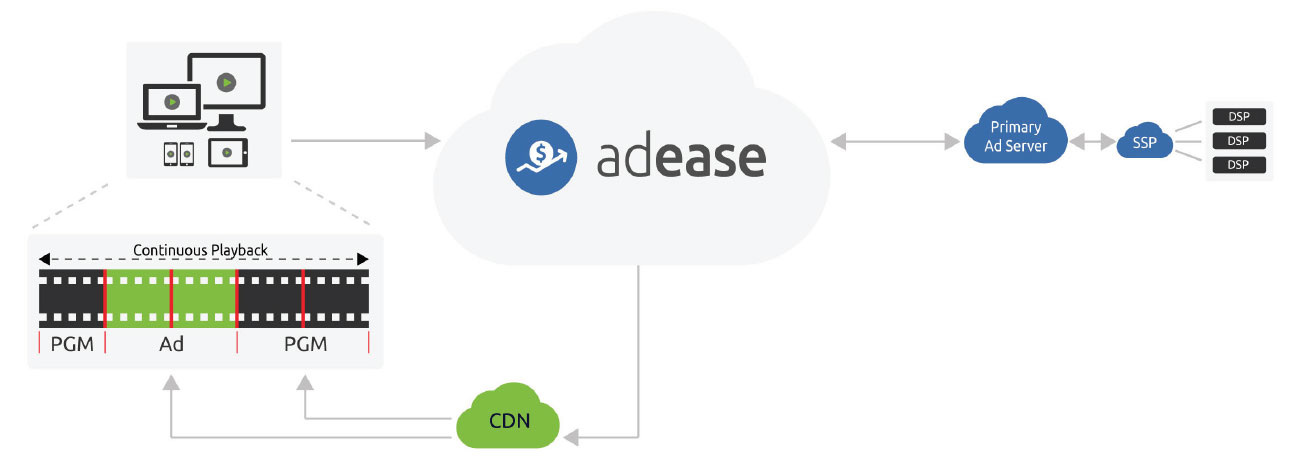Tim Armstrong, General Manager of AdEase, Ad Technology at Switch Media recently talked with Kurt Michel, Trender Research about the challenges that lie ahead for advertising and the OTT industry. An interesting and informative interview featured in the Summer 2019 edition of the OTT Executive Magazine.
The State of OTT Advertising
& The Challenges Ahead
Interview by Kurt Michel with Tim Armstrong, General Manager, Ad Technology at Switch Media
Kurt: Hello Tim. Thanks for taking the time to speak with us. Can you tell me a bit about Switch Media, and more specifically, about your area of focus – Digital Video Advertising Solutions.
Tim: Hi Kurt, my pleasure! Nice to meet you. Switch Media is a global online video company with offices in Australia, Sweden, South Africa and India. We have delivered complex online streaming solutions for major worldwide events such as the Olympics, Commonwealth Games and Game of Thrones over the past 10 years. With strong roots in software development and broadcast engineering, we can deeply integrate with our client’s systems and workflows, making video effortless. We’ve been working with pay-TV provider Foxtel for 7 years to reach around 30% of Australians, so we’ve got a lot of experience delivering OTT at scale. As mentioned, my area of focus is in Digital Video Advertising solutions– specifically AdEase, our Server-side ad insertion (SSAI) solution. The vision is to help media owners deliver a great ad experience for end-users while elevating the advertiser’s value. It’s a clever product that delivers a consistent viewing experience to users across any connected device. We’ve architected the product in a way for media owners to best utilize advertising technology to generate the maximum revenue.
Kurt: Thanks, Tim. Nice summary. It seems that even as the SVOD wars heat up, more attention is being given to ad-supported offerings for viewers. At our OTT Executive Summit this year, there was a great deal of discussion around Ad-based VOD and Ad-supported live/linear services, because these services are “free” to consumers. Are you seeing market indications that the demand for ad-based OTT solutions and services is accelerating?
Tim: With an increasing amount of Live content now delivered via OTT, we can turn the focus from SVOD and AVOD towards supplemented advertising. My observations across the OTT industry are of increasing challenges and media owners pivoting to hybrid-based models, capturing more user preferences with a blend of available options1. A recent article referenced testing of this in Europe, with strong recommendations towards broadcasters needing an ad-free subscription option. There is always attractiveness in free services, however, success is founded on the variety and selection of content. Traditional public broadcasting businesses can be sustained with an OTT advertising-funded model, while others are ever reliant on advertising sales generated for traditional linear broadcast channels. We will reach a tipping point; but we need to keep in mind that with inventories being more accessible for OTT, greater accountability around curation and management of the audience data is an increasing focus. The demand for addressable advertising, whether at the individual or household level, is growing quickly. With some of the enhancements in technology for OTT, we see a greater ability to connect advertisers with users. We are now moving from a model where each unique session is supported by user data at the point of ad request to a focus around the effective management and curation of user data. When it comes to programmatic, which is primarily driven through data and inventory matching, being able to effectively categorize a user is crucial, even while simultaneously meeting data collection regulatory requirements. For businesses working towards an advertising-funded model, making the right ad tech investment, to begin with is going to mitigate costly challenges moving forward. Like anything, a solid underlying foundation creates the ideal platform for innovation, growth and added value. Building these foundations or platforms is something we have been doing successfully for over a decade.
Kurt: Server-Side Ad Insertion (SSAI) is positioned as an improvement over “traditional” ways of delivering ads to OTT viewers. Could you compare/contrast how the systems are functionally different?
Tim: Traditional online video advertising has until recently been delivered using client-side ad serving. That means the ads are delivered to the viewer’s end device as a separate stream from the primary content, and the device switches between the primary content and the ad content. The experience is controlled within the viewer’s device. Although previously an acceptable form of ad delivery, today’s users expect a higher quality online video experience. Client-side advertising is often clunky, with buffering caused by switching between software players for program content and ads within the viewer device. Users are exposed to black screens and spinning wheels while waiting for ad playback starts and when returning to the program content after the ad break. . Due to these issues, Client-side ad serving over time has led to increased consumer frustration. Also, as the ads are called by the client, ad blockers can detect calls to an ad server and block them, meaning lost revenue for the media owner Server-side ad insertion is a significant improvement over the client-side experience. In this method, servers in the network are responsible for providing the device player with the information it needs to pull the video stream. there is only one player, and it is unaware of what parts of that stream are primary content and advertising. We’ve gathered market feedback and seen an increasing shift to server-side ad insertion as a standard practice. It was not only inevitable but highly beneficial.
Kurt: What are the benefits of SSAI compared to the traditional systems?
Tim: Put simply, it comes down to optimal viewer experience and increased ad revenue over client-side advertising. There are several elements to this; such as transcoding of video advertising creative to match the quality of the content being consumed. Not only is it quality-matched, but the advertising is stitched into the video stream manifest (the “script” given to the player that tells it where to pull video streams from) to support a seamless content-to-advertising transition. That delivers a consistent TV-like viewing experience and mitigates the efficacy of ad blockers. For advertisers and consumers, an additional benefit of SSAI is that advertising can be called prior to the ad break and held for the user in a personalized advertising playlist, driven by user-based data. The media owner benefits from SSAI through an increase in customer sentiment and a reduction in consumer churn. Revenue is also improved, as SSAI is not susceptible to ad blockers, and increased CPMs are achieved via improved targeting capabilities. For the viewer, more relevant advertising delivery can be delivered through the creation of individual sessions and a personalized manifest for each unique playback, whether for on-demand or live content. From a functional perspective, the viewer data available for each of those unique playback sessions passes to the advertising demand-side platform (DSP) through a standards-based Video Ad Service Template (VAST) conversation; which, in turn, sources appropriate ad videos to fill the required opportunities. Once the ad video file is returned, the SSAI engine transcodes each unique advertising creative, aligning encodings with the profiles the media owner is supporting from a playback perspective. Those transcoded advertising creatives are then stitched into the video manifest and accompanied by a package to handle the relative tracking and measurement beacons. This is all done in advance of actual playback. From the player software’s perspective, there is no clear distinction between content and
advertising. Ad-blocking software struggles to identify the presence of an ad when it is stitched into the manifest by the network.
Kurt: Much has been said about OTT’sability to individually target viewers with ads that are relevant to them, but deployments still seem to be “in the future.” What are the blockers to the scalability of this capability to millions of viewers? Where are the bottlenecks? Are the challenges technical, business process, or a combination? Have you seen any implementations that can do that at a practical scale?
Tim: This is a great question! You will get widely varying responses depending on who you talk to on this. To target individuals and households, deep integration into the media owner’s data management platform or identity management platform is required. We’ve built the features and capabilities of our product to make this as effective as possible. SSAI is middleware connecting between video delivery and advertising monetization technology, handling the targeting data as effectively as possible to increase the value of each ad impression. Many of the solutions in the market have been developed from a technology perspective, with limited experience of the inner mechanics of advertising monetization and their underlying technologies; we’ve been driving the AdEase roadmap with a primary focus on what’s important to advertisers. Individual viewer targeting works and effective implementations exist; however, there is a misunderstanding that because each viewer is delivered a personalized manifest, they won’t get the same advertising as others. The data system that feeds advertising personalization must support it. Finding the balance between privacy and personalization continues to be a fundamental challenge for the industry.
Kurt: Is the goal to deliver a TV-like experience on all our devices? Or are there ways to leverage some of the unique aspects of our various devices to deliver advertising in new and innovative ways?
Tim: The difference in ad opportunities between Traditional broadcast and digital OTT are worlds apart. With traditional broadcast the level of flexibility and options as an advertiser are restrictive, making this channel more applicable to those seeking mass audiences and reach. Advertising placements are sold by the time of day, day of the week, and content ratings – there’s less complexity around where to invest, making it easier for buyers. But the lack of measurement encumbered the ability to effectively measure and return on investment. As audiences’ transition to digital OTT platforms, the options and flexibility for advertisers have grown exponentially. For clarity, let’s not ignore that many characteristics of traditional broadcast advertising continue to exist in this new world. With the ability to execute data-driven campaigns in an environment that supports measurement, advertisers can think very differently about engaging their target audiences. A more fluid and dynamic environment presents measurable paths a viewer/consumer can pursue in response to your advertising; continuing industry focus will be on closing the attribution loop. As digital OTT captures a greater proportion of audiences then the rigid ad break structures of traditional television will change in accordance, advertisers will gain additional choice around the length of ads, duration of ad break and of course the choice of audiences to target. As OTT usage increases, platforms for innovation continue to evolve. In terms of formats and approaches from an advertising perspective, the Interactive Advertising Board (IAB) recently released a draft of their new Secure Interactive Media Interface Definition (SIMID). The IAB is doing great work as they help drive standardization; we saw massive growth and utilization in Video Player Ad Interface Definition (VPAID) and there is no doubt we are going to see similar interactive advertising and functionality through VAST4.1.
Kurt: Do you envision a day any time soon when an advertiser can identify their target audience in detail, enter that information in the Demand-Side Platform (DSP) and not only reach the desired audiences, but get real-time attribution?
Tim: That’s the light at the end of the tunnel, right? Technically this is achievable today. The catch is with the regulation of data, meaning we end up with legal roadblocks to the “great detail” as you say. As an industry, greater transactable data and patience is required. Regularly we have communicated risks around how user data is utilized. If the ecosystem is closed and effectively controlled, it makes the possibility more real. Advertisers, in general, want all the data they can get hold of. Attribution will always be a tough one based on the number of channels a consumer can be targeted via daily. But one day the attribution loop will be closed at scale, and then the next challenge will be what advertising drove the conversion. In the short term, there is no lack of important challenges to solve, like cross-screen measurement for OTT.
Kurt: What new developments in Ad-based OTT distribution have you excited? Is there anything on the horizon that will dramatically propel the industry and consumer experience forward?
Tim: You cannot overstate the opportunities associated with live events and ad replacement. I mentioned earlier it’s critical that OTT experience meets that of big screen TV linear broadcast. We see an increased focus on reducing online video delivery latency to that typical of cable, terrestrial or satellite- typically 3 – 10 seconds from live. To that end, our R&D folk are working with the Common Media Application Format (CMAF), low latency HLS and the like, creating new options for live monetization. In August last year, we saw global powerhouse Amazon struggle with life streaming the US Open to the UK, with many users calling for the rights to be handed to the likes of Sky. We are keeping events like that in mind as we architect our solutions for scale. With increased scale and reduced latency of live event streaming, ad demand platforms have less and less time to prepare advertising creative to fill an ad break. With less time to make ad decisions, technology needs to be built in a way that reduces processing loads and the resulting latency. Methods such as the distribution of ad calling and pre-fetching are key features that are available, and we take advantage of those in AdEase. We also work actively with governing bodies. For example, the IAB plays a vital role, as well as the VAST4 specification that outlines the usage of a universal Ad ID for easier identification of unique advertising content. A challenge in live stream monetization is aligning consumption patterns with buyers’ strategies. Traditionally the advertisers buying online inventory have worked to evenly distribute budgets and buying strategies that are not dynamic – they don’t move with the consumers. We are working with our clients and partners symbiotically to capitalize on traffic peaks, delivering greater fill rates and efficiency. It’s going to be a very interesting couple of years!
Kurt: Tim, it sounds like we are just at the tip of the OTT advertising iceberg. While the technology keeps improving, perhaps the toughest challenges are social – what data can/cannot be used in serving ads to consumers. I cannot agree with you more than the next few years will be very interesting! Thanks for chatting with us and giving us your insight into the ever-changing world of advertising as it relates to OTT.
References: 1 . h t t p s : / / w w w . v – n e t . t v / 2 0 1 9 / 0 6 / 1 7 / uk-broadcasters-hail-the-benefits-of-having-their-ownsvod-service-alongside-avod/






